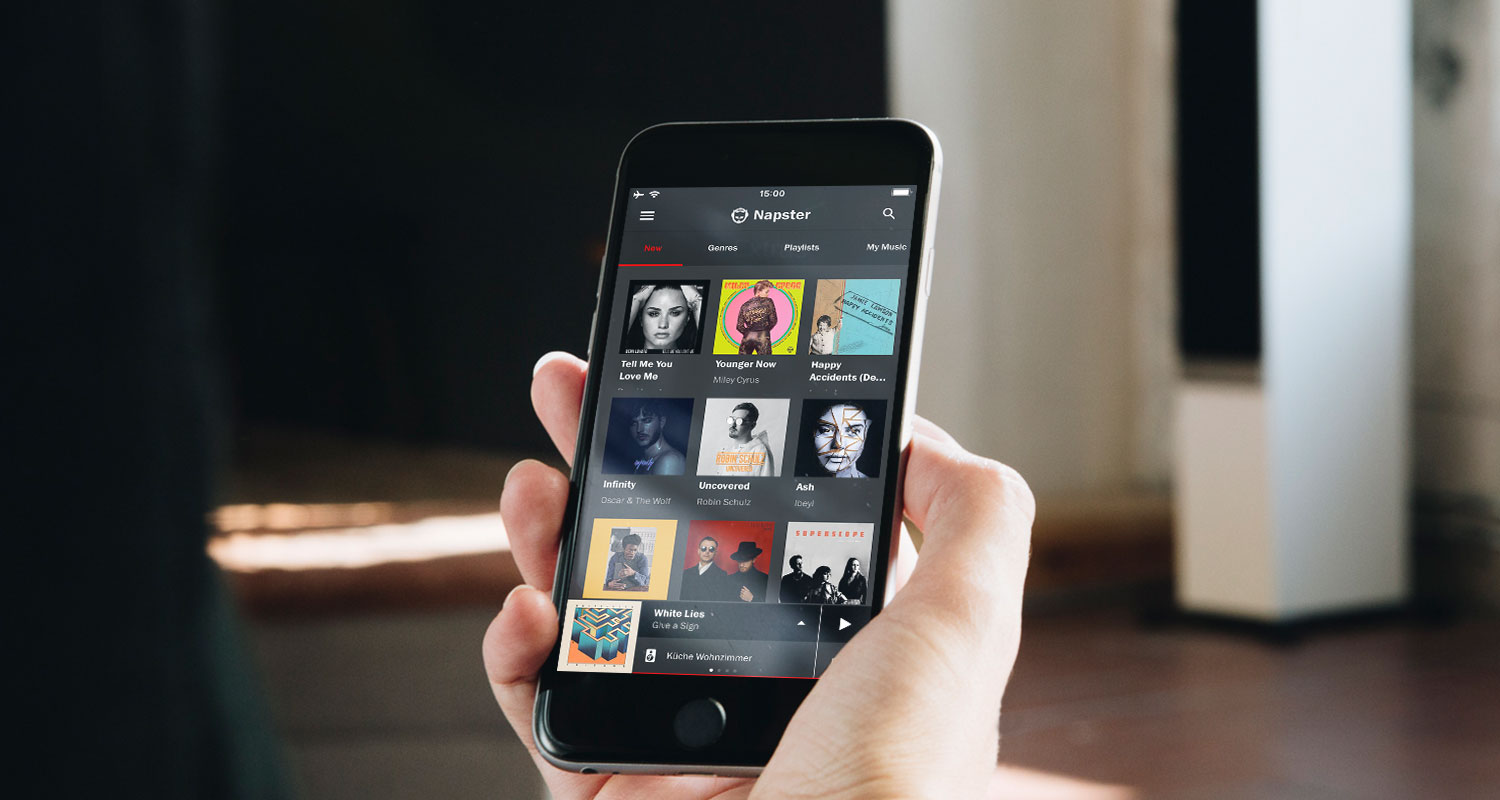Home>Devices & Equipment>Streaming>What Does Streaming Music Mean


Streaming
What Does Streaming Music Mean
Published: March 8, 2024
Learn what streaming music means and how it revolutionizes the way we listen to music. Discover the benefits and impact of streaming on the music industry.
(Many of the links in this article redirect to a specific reviewed product. Your purchase of these products through affiliate links helps to generate commission for AudioLover.com, at no extra cost. Learn more)
Table of Contents
Introduction
In today's digital age, the way we consume music has undergone a profound transformation. Gone are the days of purchasing physical albums or downloading individual tracks. Instead, we find ourselves immersed in the world of streaming music, a revolutionary concept that has redefined the music industry and our listening habits. Streaming music has become an integral part of our daily lives, offering unparalleled convenience and access to an extensive library of songs, albums, and playlists at our fingertips.
As technology continues to evolve, streaming music has emerged as the dominant method of music consumption, allowing users to access a vast array of musical content through online platforms and mobile applications. This shift in the music landscape has not only revolutionized the way we listen to music but has also sparked a wave of innovation, creativity, and accessibility within the industry.
The rise of streaming music has transcended geographical boundaries, enabling music enthusiasts from all corners of the globe to explore diverse genres, discover new artists, and connect with the latest trends in the music world. With the advent of high-speed internet and the proliferation of smart devices, streaming music has become an indispensable part of modern culture, offering a seamless and personalized listening experience tailored to individual preferences.
As we delve deeper into the realm of streaming music, it becomes evident that this phenomenon has reshaped the dynamics of the music industry, empowering both artists and listeners alike. The democratization of music distribution and consumption has paved the way for independent artists to reach a global audience, while simultaneously providing music enthusiasts with an unparalleled level of accessibility and choice.
In the following sections, we will explore the intricacies of streaming music, from its definition and historical evolution to the inner workings of popular streaming services. Additionally, we will delve into the advantages and disadvantages of streaming music, shedding light on its impact on the future of music consumption. Join us on this journey as we unravel the captivating world of streaming music and its profound influence on the way we experience and enjoy music.
Definition of Streaming Music
Streaming music refers to the method of delivering audio content in real-time over the internet, allowing users to listen to music without the need for downloading the files to their devices. This innovative approach enables individuals to access a vast library of songs, albums, and playlists through various online platforms and mobile applications. Unlike traditional methods of music consumption, such as purchasing physical albums or downloading digital tracks, streaming music offers instantaneous access to an extensive catalog of musical content.
At its core, streaming music leverages the power of the internet to transmit audio data in a continuous flow, enabling users to listen to their favorite songs on-demand or explore curated playlists tailored to their preferences. This seamless and dynamic mode of music delivery has revolutionized the way people engage with music, providing a convenient and personalized listening experience that transcends the limitations of physical media and traditional distribution channels.
One of the defining features of streaming music is its on-demand nature, allowing users to choose specific songs or albums and play them instantly, eliminating the need for storing large music libraries on their devices. Additionally, streaming music services often employ sophisticated algorithms and recommendation systems to suggest new music based on users' listening habits, fostering music discovery and exploration.
Furthermore, streaming music encompasses various business models, including subscription-based services, ad-supported platforms, and hybrid models that offer both free and premium tiers. These models enable users to access music content either for free with occasional advertisements or through paid subscriptions that unlock additional features such as ad-free listening, offline playback, and higher audio quality.
In essence, streaming music represents a paradigm shift in the way music is distributed, consumed, and experienced. By harnessing the capabilities of digital technology and the internet, streaming music has democratized access to music, empowering listeners to explore diverse genres, discover new artists, and enjoy a virtually limitless collection of songs from any location with an internet connection. This evolution in music consumption has redefined the relationship between artists, listeners, and the music industry, ushering in a new era of accessibility, convenience, and boundless musical exploration.
History of Streaming Music
The history of streaming music traces its roots back to the early days of the internet and the rapid advancements in digital audio technology. While the concept of streaming music may seem like a recent development, its origins can be linked to pioneering efforts that laid the groundwork for the modern streaming landscape.
The emergence of RealNetworks' RealAudio in the mid-1990s marked a significant milestone in the history of streaming music. RealAudio, a groundbreaking audio streaming technology, enabled users to listen to live audio broadcasts and pre-recorded content over the internet. This innovation heralded a new era of online audio delivery, paving the way for the widespread adoption of streaming music in the years to come.
The late 1990s witnessed the rise of peer-to-peer (P2P) file-sharing networks, including Napster, which revolutionized the music industry and sparked a paradigm shift in music consumption. While Napster's model was centered around file downloads, its disruptive impact foreshadowed the transformative potential of digital music distribution.
The early 2000s saw the introduction of pioneering streaming services such as Pandora, which leveraged algorithmic music recommendation systems to deliver personalized radio stations based on users' musical preferences. This marked a pivotal moment in the evolution of streaming music, showcasing the power of data-driven algorithms in shaping the listening experience.
The launch of Spotify in 2008 marked a watershed moment in the history of streaming music. With its comprehensive library of songs, on-demand playback, and freemium subscription model, Spotify redefined the landscape of music streaming, setting the stage for the rapid expansion of the streaming market.
In subsequent years, streaming music services such as Apple Music, Amazon Music, and Tidal entered the fray, intensifying competition and driving innovation in the industry. The proliferation of high-speed internet and the widespread adoption of smartphones further accelerated the growth of streaming music, making it a ubiquitous and indispensable part of modern music consumption.
The history of streaming music is a testament to the relentless innovation and technological advancements that have reshaped the music industry. From the early experiments with audio streaming to the global dominance of on-demand music platforms, the journey of streaming music reflects a profound shift in the way we discover, access, and enjoy music in the digital age.
How Streaming Music Works
Streaming music operates on a sophisticated infrastructure that seamlessly delivers audio content to users in real-time, transcending the constraints of traditional music distribution. At its core, the process of streaming music involves a series of intricate steps that enable the seamless transmission and playback of audio data over the internet.
-
Content Delivery: The journey of streaming music begins with the digital audio content residing in vast server farms or cloud-based storage systems. These repositories house an extensive catalog of songs, albums, and playlists, ready to be accessed by users across the globe.
-
Data Compression: Prior to transmission, the audio data undergoes compression to optimize bandwidth utilization and ensure efficient delivery. Advanced audio codecs such as MP3, AAC, and Ogg Vorbis are commonly employed to compress the audio files without compromising perceptible quality.
-
Streaming Protocols: Streaming music platforms utilize specialized protocols such as HTTP Live Streaming (HLS), MPEG-DASH, and RTMP to transmit audio data over the internet. These protocols facilitate adaptive bitrate streaming, allowing the platform to dynamically adjust the quality of the audio stream based on the user's network conditions.
-
User Authentication and Authorization: When a user selects a song or playlist, the streaming platform authenticates the user's credentials and authorizes access to the requested content based on the user's subscription tier or the platform's licensing agreements.
-
Buffering and Playback: As the audio data begins to stream, the platform employs buffering mechanisms to preload a portion of the content, ensuring uninterrupted playback even in the presence of network fluctuations. The audio data is decoded and played back in real-time, synchronizing with the user's playback controls.
-
Dynamic Bitrate Adjustment: To adapt to varying network conditions, streaming music services dynamically adjust the bitrate of the audio stream, optimizing playback quality while minimizing buffering interruptions. This adaptive bitrate streaming ensures a smooth and uninterrupted listening experience across diverse network environments.
-
Personalization and Recommendations: Streaming music platforms leverage user data and listening habits to deliver personalized recommendations, curated playlists, and algorithmically generated radio stations, enhancing the overall music discovery and exploration experience.
-
Licensing and Royalties: Behind the scenes, streaming music platforms navigate a complex web of licensing agreements with record labels, publishers, and collecting societies to ensure that artists and rights holders receive fair compensation for the use of their music.
In essence, the intricate workings of streaming music encompass a blend of cutting-edge technology, data-driven algorithms, and seamless delivery mechanisms, culminating in a captivating and immersive music listening experience for users worldwide.
Popular Streaming Music Services
The realm of streaming music is populated by a diverse array of platforms that cater to the varied preferences and listening habits of music enthusiasts. These popular streaming music services have redefined the way people access, discover, and engage with music, offering a rich tapestry of features, content libraries, and personalized experiences. Let's explore some of the leading streaming music services that have left an indelible mark on the industry:
Spotify
As a trailblazer in the streaming music landscape, Spotify has garnered a massive global following with its extensive library of songs, albums, and playlists. Offering both free ad-supported and premium subscription tiers, Spotify provides users with on-demand playback, personalized recommendations, and the ability to create and share custom playlists. Its algorithmically curated playlists and podcasts have solidified its position as a go-to platform for music discovery and exploration.
Apple Music
Backed by the tech giant Apple, Apple Music has emerged as a formidable contender in the streaming music arena. Boasting a vast catalog of music, exclusive releases, and original content, Apple Music integrates seamlessly with the Apple ecosystem, offering subscribers access to a diverse range of genres and curated radio stations. With features such as spatial audio and lossless audio quality, Apple Music appeals to audiophiles seeking high-fidelity music streaming experiences.
Amazon Music
Amazon Music encompasses a multi-faceted streaming platform that caters to diverse listener preferences. With offerings such as Amazon Music Unlimited and Amazon Prime Music, the service provides access to millions of songs, hands-free voice control through Alexa-enabled devices, and a robust selection of curated playlists. Amazon Music HD further elevates the audio quality with high-definition and Ultra HD streaming options, appealing to discerning music aficionados.
Tidal
Distinguished by its emphasis on high-fidelity audio and exclusive artist-driven content, Tidal has carved a niche for itself in the streaming music landscape. Tidal's commitment to lossless audio streaming, immersive sound formats, and artist royalties has resonated with audiophiles and music purists. Additionally, Tidal's focus on original video content and live concert streams sets it apart as a holistic music and entertainment platform.
YouTube Music
Leveraging the vast repository of music content on YouTube, YouTube Music offers a seamless transition from music videos to audio streaming, providing users with an extensive collection of official tracks, live performances, and remixes. With features such as background playback, offline listening, and personalized recommendations based on YouTube viewing history, YouTube Music has established itself as a compelling destination for music enthusiasts immersed in the YouTube ecosystem.
Deezer
Known for its global reach and diverse music catalog, Deezer offers a compelling blend of on-demand streaming, personalized playlists, and editorial recommendations. Deezer's focus on local content and international music curation has resonated with users worldwide, fostering a vibrant community of music discovery and cross-cultural exploration.
These popular streaming music services exemplify the dynamic and multifaceted nature of the streaming music landscape, catering to a spectrum of user preferences and elevating the music listening experience through innovation, personalization, and diverse content offerings.
Advantages of Streaming Music
Streaming music offers a myriad of advantages that have reshaped the way we consume and experience music in the digital age. From unparalleled convenience to boundless access to diverse musical content, the benefits of streaming music extend far beyond traditional modes of music consumption. Let's delve into the compelling advantages that define the allure of streaming music:
1. Unlimited Access
Streaming music provides users with instant access to an extensive library of songs, albums, and playlists from virtually any location with an internet connection. This unparalleled accessibility transcends the limitations of physical media and traditional music stores, empowering listeners to explore diverse genres, discover new artists, and indulge in a rich tapestry of musical content without constraints.
2. Personalized Listening Experience
One of the hallmark advantages of streaming music is the ability to tailor the listening experience to individual preferences. With personalized recommendations, algorithmically curated playlists, and the option to create custom playlists, users can immerse themselves in a musical journey that resonates with their unique tastes and moods. This personalized approach fosters a deeper connection with music and enhances the overall listening experience.
3. On-Demand Playback
Streaming music platforms offer on-demand playback, allowing users to choose specific songs, albums, or playlists and play them instantly without the need for downloading or storing audio files. This flexibility empowers listeners to curate their own musical soundtrack, replay favorite tracks, and explore new releases at their convenience, amplifying the sense of musical freedom and control.
4. Cross-Device Compatibility
The seamless integration of streaming music across multiple devices, including smartphones, tablets, computers, and smart speakers, ensures a cohesive and interconnected listening experience. Whether at home, on the go, or in transit, users can effortlessly transition between devices, maintaining continuity in their music consumption and enhancing the portability of their music library.
5. Music Discovery and Exploration
Streaming music platforms serve as fertile ground for music discovery, enabling users to unearth new artists, delve into niche genres, and stay abreast of emerging trends in the music landscape. Through personalized recommendations, curated playlists, and artist radio stations, listeners can embark on a journey of musical exploration, broadening their musical horizons and fostering a spirit of discovery.
6. Cost-Effective Access
The subscription-based model of streaming music services offers a cost-effective alternative to traditional music purchases, providing access to a vast catalog of music at a fraction of the cost of purchasing individual albums or tracks. This affordability democratizes access to music, making it more inclusive and accessible to a broader audience.
7. Environmental Impact
By reducing the reliance on physical media and embracing digital distribution, streaming music contributes to a more sustainable and eco-friendly approach to music consumption. The shift towards digital streaming minimizes the environmental footprint associated with manufacturing, packaging, and transporting physical music products, aligning with the principles of environmental conservation and sustainability.
In essence, the advantages of streaming music converge to redefine the way we engage with music, offering a tapestry of benefits that enrich the listening experience, foster musical discovery, and transcend the confines of traditional music consumption. As streaming music continues to evolve and innovate, its advantages resonate with a global audience, shaping the future of music consumption in profound and transformative ways.
Disadvantages of Streaming Music
While streaming music has ushered in a new era of accessibility and convenience, it also presents certain drawbacks that warrant consideration. Understanding the potential disadvantages of streaming music is essential for gaining a comprehensive perspective on its impact on music consumption and the industry as a whole.
1. Dependence on Internet Connectivity
Streaming music is inherently reliant on a stable internet connection for seamless playback. In areas with limited or unreliable internet access, users may encounter buffering issues, interruptions in playback, or the inability to access their music library altogether. This dependence on internet connectivity can pose challenges for individuals in remote locations or areas with inadequate network infrastructure.
2. Quality of Audio Playback
While streaming music platforms offer a wide range of audio quality options, including standard, high-definition, and lossless formats, the perceptible difference in audio fidelity may not be discernible to all listeners. Audiophiles and music purists, in particular, may find the audio quality of streaming music to be inferior to physical media or high-resolution audio formats, impacting their overall listening experience.
3. Artist Compensation and Royalties
The issue of artist compensation and royalties in the streaming music ecosystem has been a subject of debate and scrutiny. Despite the widespread adoption of streaming platforms, concerns persist regarding the fair remuneration of artists and songwriters, especially for independent and emerging musicians. The complex web of licensing agreements and revenue distribution models has sparked conversations about the equitable treatment of creators within the streaming music landscape.
4. Platform Exclusivity and Fragmentation
The prevalence of platform-exclusive releases and content, coupled with the fragmentation of music across various streaming services, can pose challenges for listeners seeking unified access to their favorite artists and albums. Platform exclusivity deals and content restrictions may limit the availability of certain music to subscribers of specific services, potentially fragmenting the music listening experience across multiple platforms.
5. Digital Rights Management and Ownership
Unlike physical media or digital downloads, streaming music does not afford users the same sense of ownership and control over their music library. The reliance on streaming platforms for access to music content introduces concerns about digital rights management, potential content removal, and the long-term availability of specific songs or albums, raising questions about the permanence and ownership of digital music collections.
6. Data Privacy and Personalization
Streaming music platforms leverage user data and listening habits to personalize recommendations and curated playlists. While this personalized approach enhances the music discovery experience, it also raises privacy considerations related to the collection, storage, and utilization of user data for targeted content delivery, necessitating a balance between personalization and data privacy safeguards.
7. Environmental Implications
While streaming music offers environmental benefits by reducing the demand for physical media, it also introduces environmental considerations related to data centers, energy consumption, and the carbon footprint of streaming infrastructure. The energy-intensive nature of data storage and transmission in streaming music services contributes to the broader discourse on the environmental impact of digital technologies.
In essence, the disadvantages of streaming music underscore the nuanced complexities inherent in the shift towards digital music consumption. By acknowledging these drawbacks, stakeholders in the music industry and consumers alike can engage in informed discussions about the evolving landscape of music distribution, technological advancements, and the implications of streaming music on artistic compensation, user experience, and environmental sustainability.
The Future of Streaming Music
The future of streaming music unfolds against a backdrop of continual innovation, evolving consumer behaviors, and dynamic shifts in the music industry landscape. As technology continues to advance and user preferences undergo transformation, the trajectory of streaming music points towards a realm of boundless possibilities and transformative developments.
One of the pivotal aspects shaping the future of streaming music is the convergence of immersive audio technologies and spatial audio formats. With the advent of spatial audio, augmented reality (AR), and virtual reality (VR) experiences, streaming music is poised to transcend traditional stereo playback, offering listeners a heightened sense of immersion and spatial awareness within the musical environment. This evolution in audio fidelity and spatial rendering holds the potential to redefine the listening experience, blurring the boundaries between physical and virtual spaces, and ushering in a new era of sensory engagement with music.
Furthermore, the future of streaming music is intricately intertwined with the proliferation of artificial intelligence (AI) and machine learning algorithms. These technologies are poised to revolutionize music discovery, content curation, and personalized recommendations, enabling streaming platforms to anticipate and cater to the nuanced preferences and moods of individual listeners. By harnessing the power of AI, streaming music services can elevate the level of personalization, adaptability, and serendipitous discovery, fostering deeper connections between users and the vast musical landscape.
As the global music streaming audience continues to expand, the future of streaming music also encompasses a heightened focus on global music diversity, cultural inclusivity, and equitable representation of artists from diverse backgrounds. Streaming platforms are increasingly embracing localized content, regional genres, and cross-cultural collaborations, amplifying the visibility of artists and musical traditions that have historically been underrepresented in mainstream channels. This emphasis on inclusivity and cultural resonance reflects a broader commitment to fostering a vibrant and interconnected global music community.
Moreover, the future of streaming music is intertwined with the evolution of creator-centric models, transparent royalty frameworks, and equitable compensation structures for artists and rights holders. The ongoing dialogue surrounding fair remuneration, rights management, and revenue distribution underscores the imperative of cultivating a sustainable and equitable ecosystem that empowers creators and fosters a thriving music industry.
In essence, the future of streaming music is characterized by a convergence of technological innovation, user-centric experiences, and a commitment to artistic diversity and sustainability. As streaming music continues to evolve, it holds the promise of redefining the boundaries of audio fidelity, immersive experiences, and global musical interconnectedness, shaping a future where the artistry and cultural richness of music converge with technological ingenuity to create a harmonious and inclusive musical landscape.











